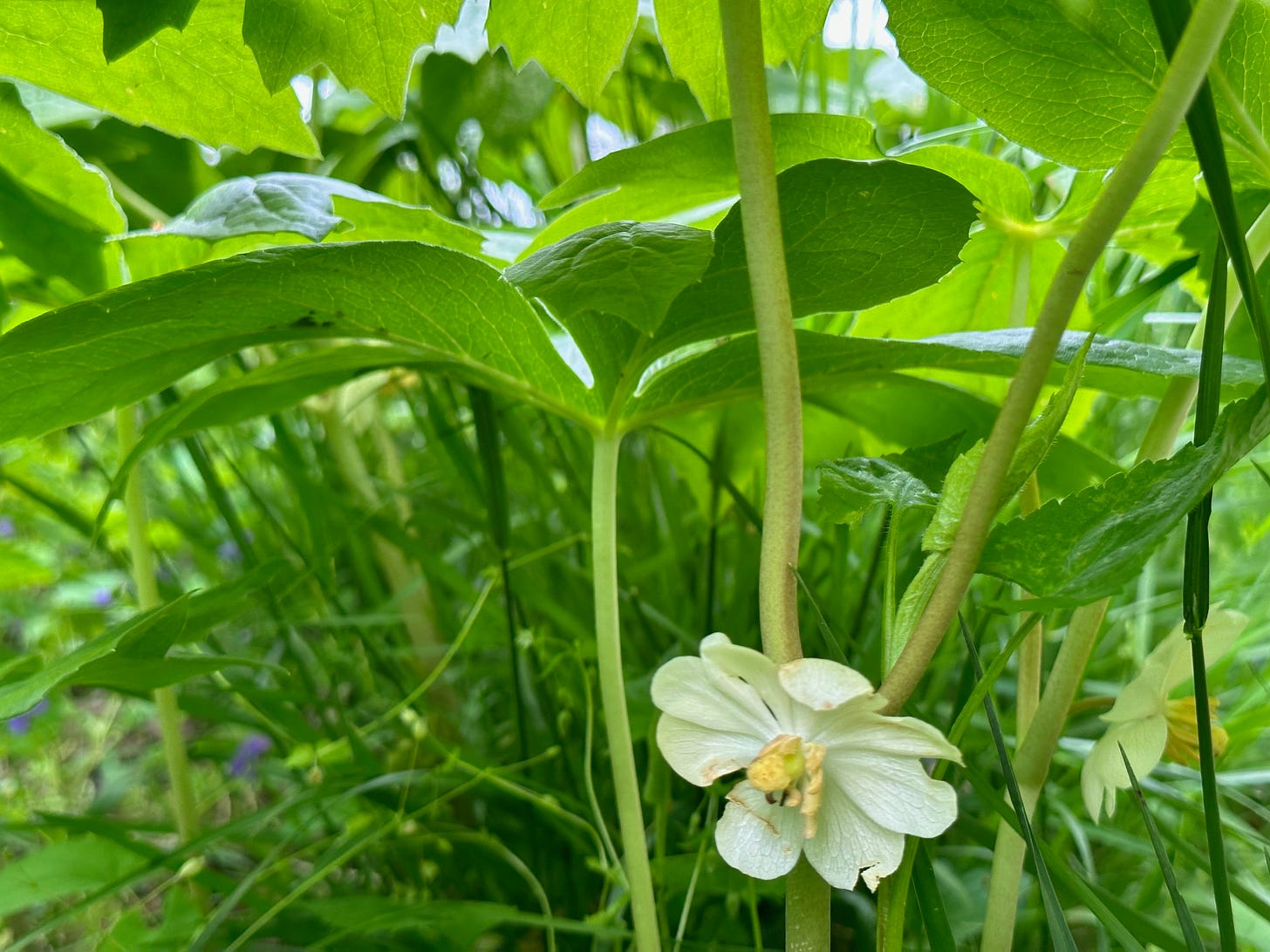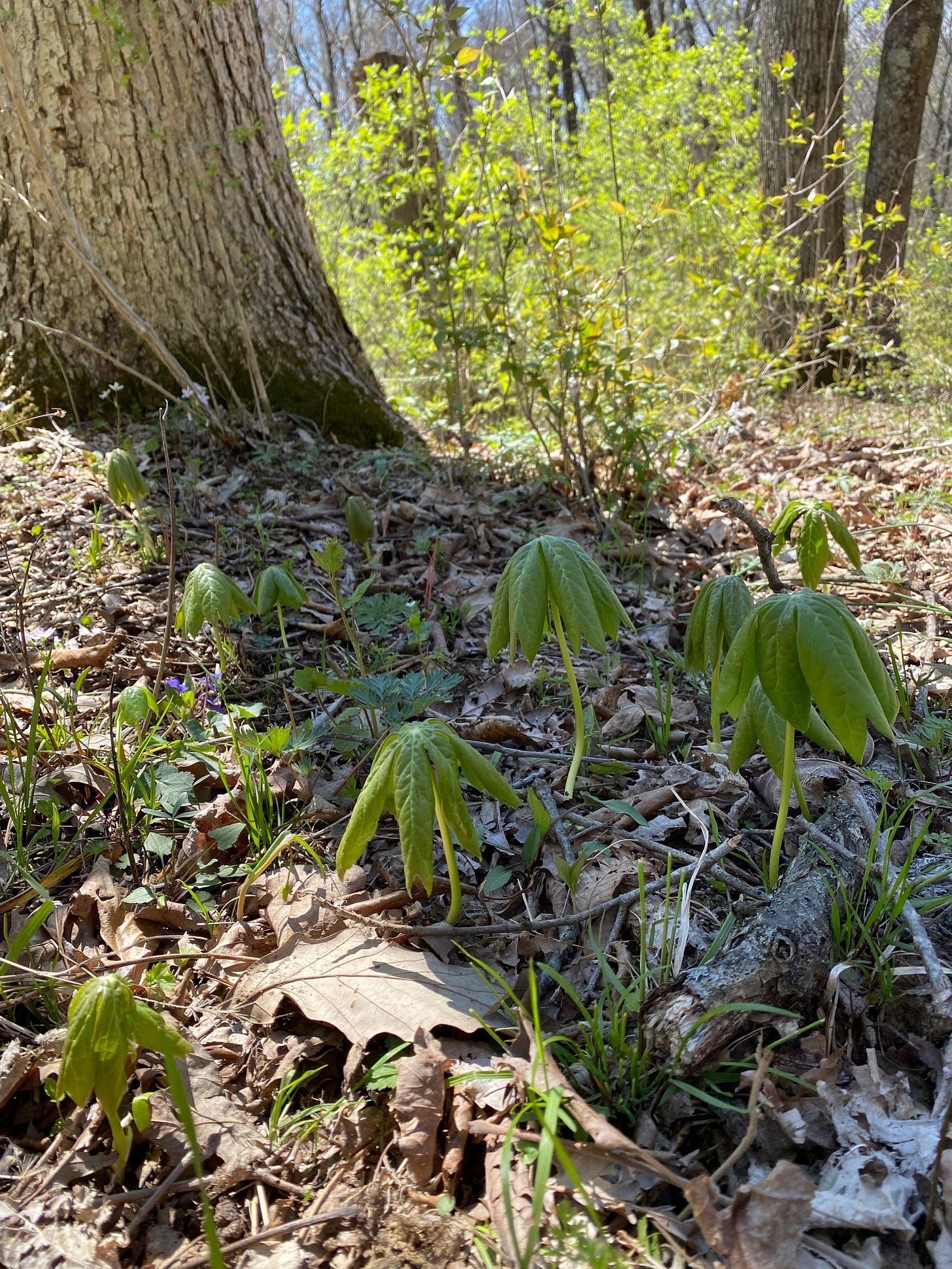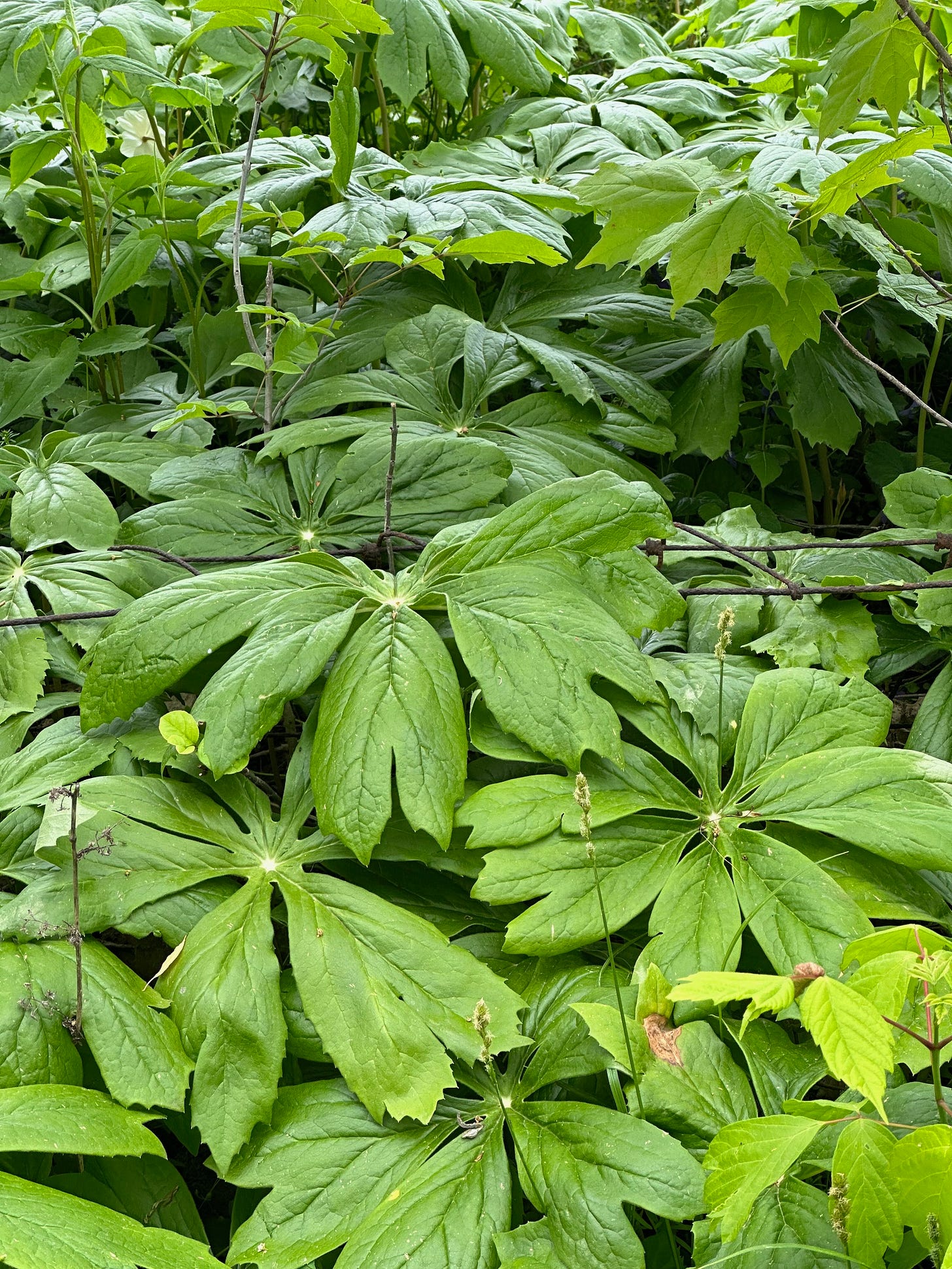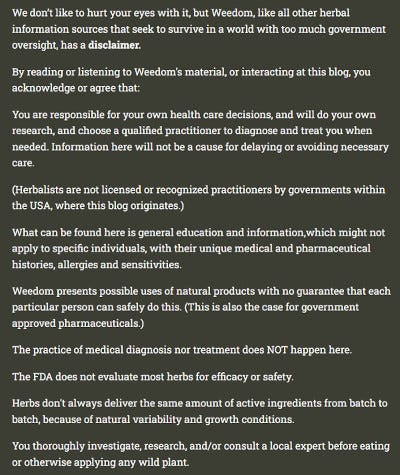Mayapple
Only 1 part of the famously toxic mayapple plant, is edible and only at a specific stage of ripeness. At its soft, yellow peak of flavor, the single oblong fruit is very tasty. Unless you’re vigilant, the raccoons, squirrels, box turtles, et al will beat you to it. Like most good things, you have to expend a little time and effort for the reward, and in this case slog through some medical info before contemplating the rare delicacy that presents itself in perhaps late July through August.
The rest of the mayapple plant (leaves stem and roots) is toxic to the point of being used indigenously as a strong purgative laxative, to treat parasites, for suicide, and for abortions that often took the mother with the baby. Podophyllotoxin is the name of the major, culprit molecule. This compound has been employed in topical pharmaceuticals which helped initiate pharmacists to the world of counselling patients on very personal matters, in less than adequate conditions of privacy. The irritant compound is relegated to the treatment of such maladies as genital warts and molluscum contagiosum. Topical application is a fairly arduous procedure which involves coating the affected areas while protecting the surrounding unaffected tissues, and waiting for the product to dry before allowing contact with opposing skin.
In the pharmacognosy world, the adoption of an unaltered natural compound into the world of big pharma is always a notable event. Such was the case with podophyllotoxin, which bears the generic name podofilox for obvious marketing reasons. Even more semi-synthetic bonuses were spun off from this compound, and marketed as cytotoxic, anti-cancer drugs such as etoposide and teniposide. These exert their action by inhibiting an enzyme that influences DNA structure and replication, thus inhibiting tumor growth. This mechanism is much different than the parent compound. Podophyllotoxin itself is a spindle poison, which inhibits the formation of tubulin, and interrupts the processes of chromosome separation as cells divide. Poisoned cells are stuck in metaphase during division, which causes them to undergo necrosis and die. This mechanism is closer to pharmaceuticals such as colchicine, (from the autumn crocus and glory lily) paclitaxel (a diterpenoid from the Pacific Yew) and vincristine-like alkaloids (derived from compounds of Vinca species.) Chemotherapy is rife with plant toxins and their derivatives. Colchicine at very low doses has numerous off label, and seemingly unrelated applications such as treatment of gout, or cardioprotection in certain cases.
Our mayapple yields a resin called podophyllin, a combination of the most abundant lignan, podophyllotoxin, as well as 4′-demethyl podophyllotoxin, α- peltatin and β-peltatin. This resinous extract from the plant has been used directly since the 1800’s for various skin maladies. In later years, the natural resin, at 25% concentration has been administered topically in physicians offices, but has lost favor due to the potential for internal absorption and toxicity. Use of more than the recommended 0.5 ml topically could lead to purgative side effects and organ damage.
The purified podophylloxin (a.k.a. podofilox) in a 0.5% gel or a solution has been deemed safe enough as a prescription drug for home use. That product is applied twice daily, to no more than 10 square centimeters of tissue affected with genital warts or molluscum congagiosum, for three days. The treatment is then paused for the next 4 days. This cycle can be repeated a total of 4 times, with the hope of temporarily resolving the situation. Podofilox is a treatment, not a cure. There is a reason this drug is not exactly hopping off of the pharmacy shelves: It’s irritating and the use is complicated, even though Good Rx can currently offer people 'such a deal, 75% off with coupon, $32.50.
More pharmacy “fun”: Carter’s Little Liver Pills, a purgative laxative that was supposed to stimulate bile flow, originally contained podophyllin resin and aloe. Regulators forced the company to remove “Liver” from the label since these pills really didn’t address hepatic issues. In 1959, they were reformulated to contain the laxative bisacodyl, and are still sold as Carter’s Little Pills to this day.
Now that most people have been talked out of podofilox, podophyllin, as well as retail pharmacy practice, we can proceed to more pleasant things.
Mayapple looks like a tropical plant perhaps from the era when dinosaurs roamed the earth. Botanically known as Podophyllum peltatum, of the family Berberidaceae, it springs up from the ground in March to April in our region, puts out a single bloom in May, and if successful, the single edible fruit is ready usually by August. The mayapple, (also called American mandrake, or umbrella leaf ) is a perennial plant. In Spring, a single root can send up several sprouts. It occupies S.E. parts of Canada, and the Eastern and Midwest U.S. in USDA zones 3a through 8b. Most often, a new plant with only one leaf will not bloom or produce a fruit. The plants which have 2 leaves will produce a bloom at the fork of the stem, from which a single fruit will form. The mayapple leaf is deeply cut, almost all the way to the center, with 4-8 radially arranged lobes. Each lobe is often split into 2 secondary lobes at the distal end. Leaves are smooth on top, with sparse hairs below, and may be irregularly toothed at the margins. Leaf veins are palmate. The leaves form an umbrella, perhaps 1 to 1.5 feet (30-45 cm.) or so from the ground, under which the single bloom and later the fruit are concealed.

The single bloom dangles from an axil at the fork of the plant, has 6 light green sepals, and 6 or more white, waxy petals. It’s usually 2-3 inches in diameter (5-7.5 cm.). Up to 18 yellow anthers atop white filaments surround the central pistil. This bloom usually appears in early May in weedom-land, Midwest USDA zone 6. If successful, it produces a single fruit that ripens, usually in August. This time can vary widely with the latitude. Mayapple plants tolerate shade, but those which grow at the edge of the woods, and get partial sun are more likely to produce fruit.
The slightly oblong fruit ranges from 1 - 2.5 inches in diameter. It should not be eaten until it’s soft and yellow, and is easily separated from the plant. Look for ripe fruit when the mayapple plants are looking rough, with the leaves in decline, turning yellow to brown. The seeds and the outer peel are not considered edible, though foragers report swallowing some seeds whole, without issue. Consider the somewhat toxic seeds and bitter peel to be the most dose limiting parts of the fruit. When nibbling the raw fruit, stick to eating the inner rind and the soft pulp within, which are pleasant and tropically sweet tasting, from mild citrus to somewhat melon flavored. It’s a punch or mocktail in a single fruit- and well worth the effort of foraging. Spit out the seeds, and avoid the bitter peel. In order to compete with the wildlife, you might have to pick some fruits which are not quite ready, and allow them to ripen in a well aerated space at home. This will work if you pick fruits that are at least partly turning a light yellow. Totally green fruits won’t ripen after they’ve been picked.
This is a fruit that pregnant women should steer away from. Remember that the rest of the mayapple plant is toxic and the podophyllin resin has the potential to irritate the skin. If you’re going to be pulling or rearranging a lot of mayapple plants, it’s a good idea to wear gloves.
Mayapple jam, pastries, and cake are a part of wild cuisine in the eastern regions of the U.S. If you are a jelly or jam artist, the best way to handle these fruits is to separate the soft inner gel like substance and the inner rind from the seeds and the peel before cooking. This way you’ll have the best flavor, as well as being able to eat higher quantities without a laxative effect. Jelly makers strain out the solids of the fruit after cooking, and retain the juice, and the jam makers can skip the straining step. Making jellies, jams, and preserves is a special skill. The pectin required is variable based on the fruit ingredients and preferences. When recipes use lemon, it’s for acidification and preservation purposes, which allow longer term storage without bacterial growth. Sugar amounts can also be varied to preference, bearing in mind that high sugar content helps with the preservation.
A suggested ratio of ingredients for jam by volume is
5 1/2 cups of mayapple innards (no peels or seeds)
1/2 cup water
1/2 cup lemon juice
7 cups of sugar
a pinch of salt
1 packet of pectin.
Bring the mayapples, water and lemon to a boil, then cover and simmer for 20 minutes. Add sugar and bring to a vigorous boil for 3 minutes. Add salt and pectin and boil for 1 minute. Stir, skim the foam and pour into sterilized jars and seal with a lid. (This general recipe pops up in numerous places including Green Deane’s “Eat the Weeds” )
If the jams are to be used up in a week or 2, they can go into the fridge. If you want a shelf stable product, process the sealed jars in a boiling water bath for 10 minutes minimum, and adjust time for additional altitude as standard canning instructions suggest.
See if you can find some mayapples this spring, and revisit them in the summer to find some fruit. Don’t forget, mayapples are a good marker plant to herald the morel mushroom hunting season. If you have experienced this fruit, or have a question, feel free to leave a comment. Happy hunting!
Where We Dig
1. Thayer S. The Forager’s Harvest - A Guide to Identifying, Harvesting, and Preparing Edible Wild Plants. Forager’s Harvest Press; 2006. https://openlibrary.org/books/OL8588402M/The_Forager's_Harvest
2. York JAM PharmD, RPh Staff Pharmacist, Jacobi Medical Center Bronx, New York Tomasz Z Jodlowski, PharmD, BCPS (AQ ID) Assistant Clinical Professor, St John’s University College of Pharmacy and Allied Health Professions Queens, New. Prevention and Treatment of Human Papillomavirus Infections. Accessed April 16, 2025. https://www.uspharmacist.com/article/prevention-and-treatment-of-human-papillomavirus-infections
3. Podophyllum: Health Benefits, Side Effects, Uses, Dose & Precautions. Accessed May 7, 2023. https://www.rxlist.com/podophyllum/supplements.htm
4. Edwards A, Atma-Ram A, Thin RN. Podophyllotoxin 0.5% v podophyllin 20% to treat penile warts. Genitourin Med. 1988;64(4):263-265.
5. von Krogh G, Longstaff E. Podophyllin office therapy against condyloma should be abandoned. Sex Transm Infect. 2001;77(6):409-412. doi:10.1136/sti.77.6.409
6. Singh A, Choudhary R, Ganguly S. Podophyllin in Dermatology: Revisiting a Historical Drug. Indian Dermatology Online Journal. 2022;13(1):167. doi:10.4103/idoj.idoj_225_21
7. Podofilox (Topical) Monograph for Professionals. Drugs.com. Accessed April 16, 2025. https://www.drugs.com/monograph/podofilox-topical.html
8. Mayapple, Mandrake - Eat The Weeds and other things, too. Accessed April 16, 2025. https://www.eattheweeds.com/podophyllum-peltatum-forgotten-fruit-2/
9. Deane G. Mayapple, Mandrake. Eat The Weeds and other things, too. August 31, 2011. Accessed April 16, 2025. https://www.eattheweeds.com/podophyllum-peltatum-forgotten-fruit-2/
10. Mayapple Foraging. Accessed April 16, 2025. http://www.islandbreath.org/TheGobbler/Articles%20Published/04%20FD%20Edibles/03%20Mayapples/fd_03_Mayapple.html
11. Andersson NW, Andersen JT. Association Between Fetal Safety Outcomes and Exposure to Local Podophyllotoxin During Pregnancy. JAMA Dermatol. 2020;156(3):303-311. doi:10.1001/jamadermatol.2019.4315







I'm learning so friggin' much about some of the plants commonplace even in my Zone 4 northern Vermont. Thanks.
Thanks for all the detailed information! I am aware of the homeopathic formulation of this plant (using the rhizomes), so it is fascinating to read about its properties in gross form.